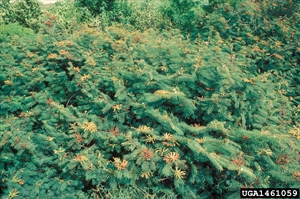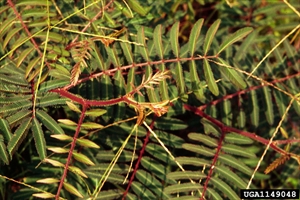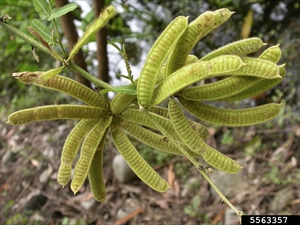- Widespread. Asia, Africa, North, South and Central America, Caribbean, Oceania. In Australia, Fiji, French Polynesia, New Caledonia, New Zealand, PNG.
- Shrub forming impenetrable thickets in grass floodplains, seasonal wetlands, swamps, waterways, ditches, and roadsides. Pastures are particularly impacted as cattle are cut off from watering points, and grazing capacity is reduced. Invasiveness due to rapid growth, ability to tolerate a range of soil types, and large seed production.
- Shrub, up to 2 m tall, with scattered thorns along stems, branches and leaf stalks. Leaves, alternate along the stems, about 20-30 cm long, divided into 6-16 pairs of leaf-like branchlets, each with about 45 pairs of leaflets. Flowerheads, 10-20 mm diameter, with about 100 pink or mauve flowers, eight stamens each, giving a fluffy look; these produce 8-20 hairy seed pods. When mature, pods break into 1-seeded pieces.
- Spread: seeds, by floodwater; machinery, vehicles, boats; movement of sand; clothing; animals - on fur and survival through the gut.
- Biosecurity: high risk of introduction; used as an ornamental and medicinally. One of the worst alien invasive weeds of wetlands of tropical Africa, Asia, Australia. Noxious weed in Florida and Hawaii, USA, northern Australia, Thailand and South Africa. Among 100 of World's Worst Invasive Alien Species (IUCN, 2020). Available on internet.
- Biocontrol: latest release in Australia is a beetle, Nesaecrepida infuscata, which attacks roots and leaves.
- Cultural control: hand weeding; slashing, plus herbicide; bulldozing; fire, plus herbicide; vehicle hygiene.
- Chemical control: in Australia: dicamba; fluroxpyr; glyphosate (and Fiji); glyphosate + metsulfuron-methyl; metsulfuron-methyl.
Pacific Pests, Pathogens and Weeds - Online edition
Pacific Pests, Pathogens, Weeds & Pesticides
Giant sensitive tree (470)
Giant sensitive tree; it also known as giant mimosa, sensitive tree, or catclaw mimosa. CABI calls it giant sensitive plant, but that name is also given to Mimosa diplotricha.
Mimosa pigra. It is a member of the Fabaceae.
AUTHORS Grahame Jackson & Aradhana Deesh
Adapted from Giant sensitive tree (Mimosa pigra) (2018) Weeds of SE Qld and Northern NSW. Lucidcentral. (https://www.lucidcentral.org/editors-pick-animal-and-plant-identification-keys/key-to-weeds-of-se-qld-and-northern-nsw); and additional information from CABI (2019) Mimosa pigra (giant sensitive plant). Invasive Species Compendium. (https://www.cabi.org/isc/datasheet/34199); and Mimosa pigra L. (2011) Weeds Australia - profiles. Department of Agriculture, Water and the Environment. (https://profiles.ala.org.au/opus/weeds-australia/profile/Mimosa%20pigra); and from Thornhill A (2020) Mimosa pigra L. Giant sensitive plant. Council of Heads of Australasian Herbaria. Department of Sustainability, Environment, Water, Population and Communities. Australian Government. (https://profiles.ala.org.au/opus/weeds-australia/profile/Mimosa%20pigra). Photo 1 Amy Ferriter, State of Idaho, Bugwood.org.
Produced with support from the Australian Centre for International Agricultural Research under project HORT/2016/185: Responding to emerging pest and disease threats to horticulture in the Pacific islands, implemented by the University of Queensland, in association with the Pacific Community and Koronivia Research Station, Ministry of Agriculture, Fiji.








